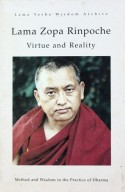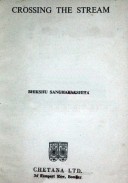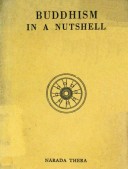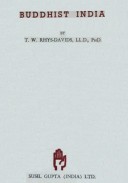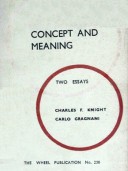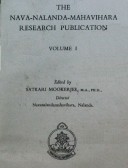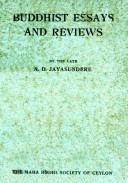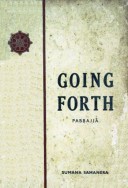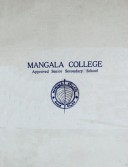Tìm Sách
Sách tiếng Anh-English >> Virtue & Reality
Thông tin tra cứu
- Tên sách : Virtue & Reality
- Tác giả : Lama Zopa Rinpoche
- Dịch giả :
- Ngôn ngữ : Anh
- Số trang : 91
- Nhà xuất bản : Lama Yeshe Wisdom Archive-USA
- Năm xuất bản : 1998
- Phân loại : Sách tiếng Anh-English
- MCB : 1210000008195
- OPAC :
- Tóm tắt :
CONTENTS
Editor’s Introduction…………………….7
Fulfilling Life’s Purpose…………………….9
Living with Bodhicitta…………………….19
Patience and the Compassionate Heart…………………….41
Meditation on Emptiness…………………….57
Practicing the Good Heart…………………….77
Dedication…………………….89
Publisher’s Acknowledgements
We are extremely grateful to our friends and supporters who have made it possible for the Lama Yeshe Wisdom Archive both to exist and to function. To Lama Yeshe and Lama Zopa Rinpoche, whose kindness is impossible to repay. To Peter and Nicole Kedge and Venerable Alisa Cameron for bringing the Archive to its present state of development. To Venerable Roger Kunsang, Lama Zopa’s tireless assistant, for his kindness and consideration. To our sustaining supporters, Drs. Penny Noyce & Leo Liu, Barry & Connie Hershey, Roger & Claire Ash-Wheeler, Joan Terry, T. Y. Alexander, Claire Atkins, Datuk Tai Tsu Kuang, Lily Chang Wu, Richard Gere, Lynnea Elkind, and Tom & Suzanne Castles. And to all our other benefactors, great and small, whose help we appreciate enormously. Without the help of all of you, our efforts for the sake of all sentient beings would not be possible. Thank you so much.
If you, dear reader, would like to join this noble group of open-hearted altruists by contributing to the production of more free booklets by Lama Yeshe or Lama Zopa Rinpoche or to the other aspects of the Lama Yeshe Wisdom Archive’s work, please contact us to find out how.
This book is published in honor of Lama Zopa Rinpoche’s visit to Boston, November 1998. We would like to thank the members of Tilopa Center for organizing and taping these teachings, Venerable Roger Kunsang for suggesting that we publish them, Venerable Thubten Munsel for transcribing the tapes, Peter Iseli for our beautifully drawn logo, Wendy Cook for her editorial suggestions, and Jennifer Martin and Garrett Brown for their help in the design and production of this book.
Editor’s Introduction
The entire Dharma, the teachings of the Buddha, can be divided into two categories—extensive method and profound wisdom. The method lineage passed from Shakyamuni Buddha to Maitreya and down through the great Indian pundits such as Asanga, Vasubandhu, Haribhadra and Suvamadvipi to the great Atisha, who brought them to Tibet. Similarly, the wisdom lineage passed from the Buddha to Manjushri and again down to Atisha through pundits such as Nagarjuna and Chandrakirti.
In Tibet, Atisha arranged the Buddha’s teachings into a graded sequence that became known as the steps of the path to enlightenment (lam-rim), the essence of which is method and wisdom. Explicitly, this path has three principal aspects— renunciation, bodhicitta and right view. The Kadampa tradition, founded by Atisha, became the basis of the Gelug school of Tibetan Buddhism, which itself was founded in the fifteenth century by the enlightened scholar and yogi, Lama Je Tsong Khapa. This tradition lives today in the minds and teachings of great masters such as His Holiness the Dalai Lama and other wonderful teachers in the Gelug tradition, of whom Lama Thubten Zopa Rinpoche, the author of this book, is one of the best known. He is the spiritual director of the Foundation for the Preservation of the Mahayana Tradition (FPMT) and the guide, refuge and protector of thousands of students all over the world.
In the context of the teachings presented here, method is the loving, compassionate bodhicitta and wisdom is the realization of ultimate reality, the right view of emptiness. It would be hard to find a simpler, clearer, more practical explanation of these two fundamental paths than the one Lama Zopa offers us here. Through practicing method, we attain the holy body of a Buddha; through developing wisdom we attain the enlightened mind.
Based on a four-day course given at an American FPMT center, Tilopa Center, Decatur, Illinois, in August, 1997, the teachings presented here detail methods for developing compassion and wisdom in our everyday lives. Recognizing the workaday world reality in which most of his students live, Rinpoche shows us how to think and act so that every moment of our lives will be of maximum benefit to both ourselves and others. What more do we need?
 Facebook
Facebook
 Google
Google
 Google+
Google+
